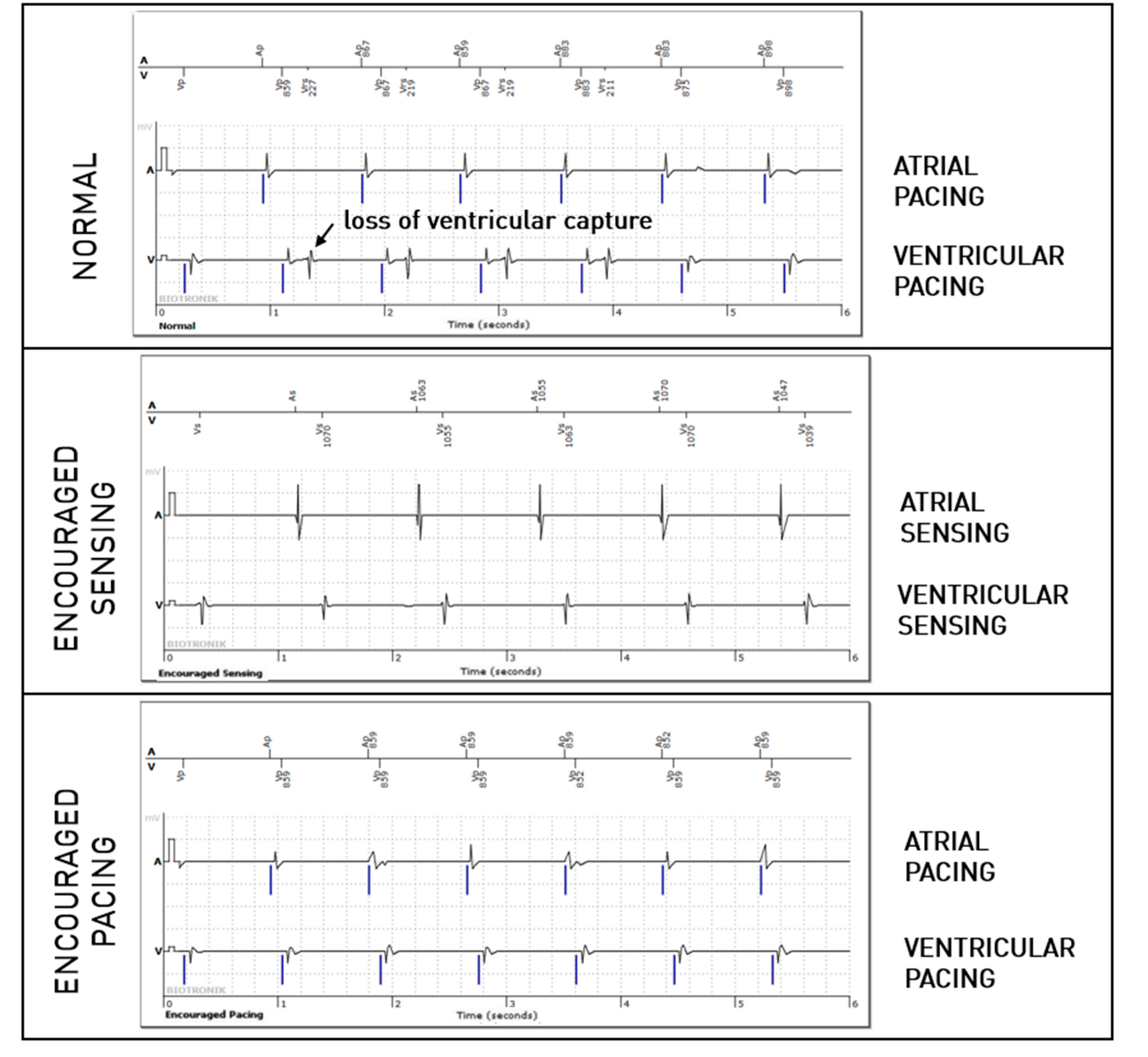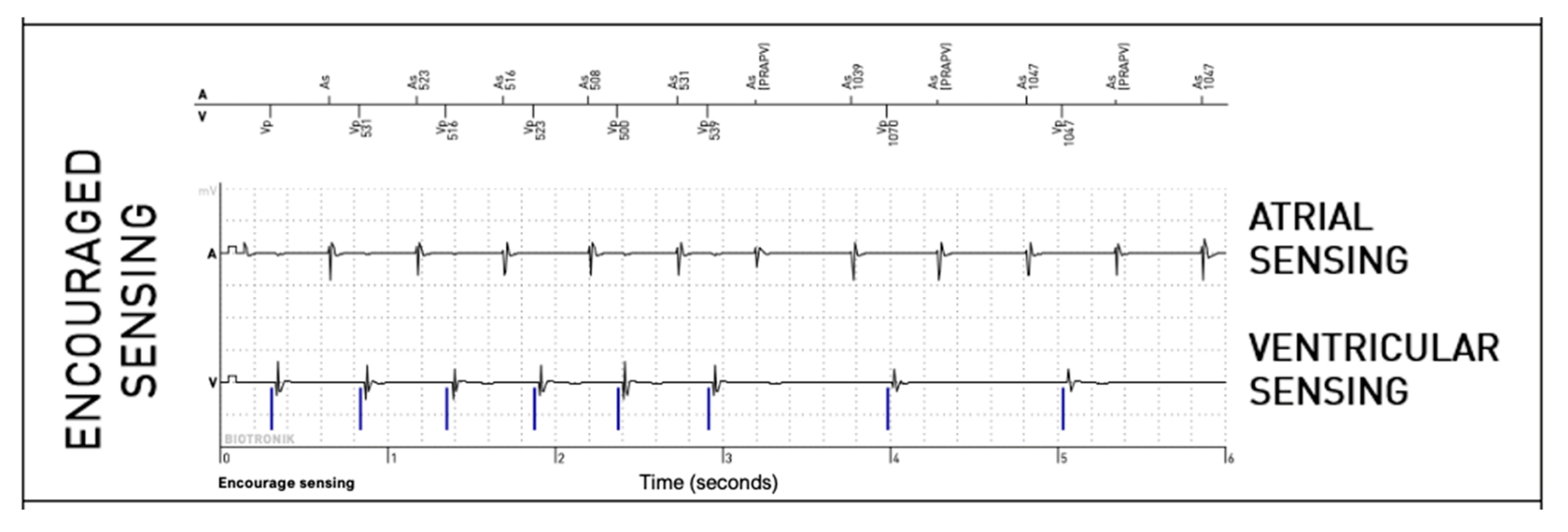Improving Diagnostic Yield for Analyzing Periodic Electrograms in the Remote Detection of Pacemaker Lead Issues
Abstract
1. Introduction
2. Materials and Methods
2.1. Periodic EGM
2.2. Study Protocol
2.3. Statistical Analysis
3. Results
3.1. Prevalence of Anomalies and Distribution Across Modes
3.2. Atrial Lead
3.3. Ventricular Leads
4. Discussion
4.1. Contribution of Active EGM
4.2. Clinical Significance
4.3. Study Limitations
5. Conclusions
Author Contributions
Funding
Institutional Review Board Statement
Informed Consent Statement
Data Availability Statement
Conflicts of Interest
References
- Greenspon, A.J.; Patel, J.D.; Lau, E.; Ochoa, J.A.; Frisch, D.R.; Ho, R.T.; Pavri, B.B.; Kurtz, S.M. Trends in Permanent Pacemaker Implantation in the United States From 1993 to 2009: Increasing Complexity of Patients and Procedures. J. Am. Coll. Cardiol. 2012, 60, 1540–1545. [Google Scholar] [CrossRef]
- Birnie, D.; Williams, K.; Guo, A.; Mielniczuk, L.; Davis, D.; Lemery, R.; Green, M.; Gollob, M.; Tang, A. Reasons for Escalating Pacemaker Implants. Am. J. Cardiol. 2006, 98, 93–97. [Google Scholar] [CrossRef]
- Molina-Lerma, M.; Cózar-León, R.; García-Fernández, F.J.; Calvo, D. Spanish Pacemaker Registry. 21st Official Report of Heart Rhythm Association of the Spanish Society of Cardiology (2023). Rev. Esp. Cardiol. Engl. Ed. 2024, 77, 947–956. [Google Scholar] [CrossRef] [PubMed]
- Vouliotis, A.I.; Roberts, P.; Dilaveris, P.; Gatzoulis, K.; Yue, A.; Tsioufis, K. Leadless Pacemakers: Current Achievements and Future Perspectives. Eur. Cardiol. Rev. 2023, 18, e49. [Google Scholar] [CrossRef] [PubMed]
- Hayes, D.L. The Next 5 Years in Cardiac Pacemakers: A Preview. Mayo Clin. Proc. 1992, 67, 379–384. [Google Scholar] [CrossRef] [PubMed]
- Slotwiner, D.; Yu, J.; Zhang, M.; Al-Khatib, S.M. Cardiac Implantable Electronic Device Patient Follow-up: Assessment of U.S. Practice. Heart Rhythm 2024. [Google Scholar] [CrossRef]
- Ploux, S.; Strik, M.; Varma, N.; Eschalier, R.; Bordachar, P. Remote Monitoring of Pacemakers. Arch. Cardiovasc. Dis. 2021, 114, 588–597. [Google Scholar] [CrossRef]
- Thiyagarajah, A.; Strik, M.; Ploux, S.; Bordachar, P. Diagnostic Approach to Suspected Lead Failure. Card. Electrophysiol. Clin. 2024, 16, 359–371. [Google Scholar] [CrossRef]
- Wallbrück, K.; Stellbrink, C.; Santini, M.; Gill, J.; Hartmann, A.; Wunderlich, E. The Value of Permanent Follow-up of Implantable Pacemakers-First Results of an European Trial. Biomed. Tech. 2002, 47 Pt 2 (Suppl. S1), 950–953. [Google Scholar] [CrossRef] [PubMed]
- Lazarus, A. Remote, Wireless, Ambulatory Monitoring of Implantable Pacemakers, Cardioverter Defibrillators, and Cardiac Resynchronization Therapy Systems: Analysis of a Worldwide Database. Pacing Clin. Electrophysiol. 2007, 30, S2–S12. [Google Scholar] [CrossRef]
- Hindricks, G.; Taborsky, M.; Glikson, M.; Heinrich, U.; Schumacher, B.; Katz, A.; Brachmann, J.; Lewalter, T.; Goette, A.; Block, M.; et al. Implant-Based Multiparameter Telemonitoring of Patients with Heart Failure (IN-TIME): A Randomised Controlled Trial. Lancet 2014, 384, 583–590. [Google Scholar] [CrossRef] [PubMed]
- Varma, N.; Piccini, J.P.; Snell, J.; Fischer, A.; Dalal, N.; Mittal, S. The Relationship Between Level of Adherence to Automatic Wireless Remote Monitoring and Survival in Pacemaker and Defibrillator Patients. J. Am. Coll. Cardiol. 2015, 65, 2601–2610. [Google Scholar] [CrossRef]
- Saxon, L.A.; Hayes, D.L.; Gilliam, F.R.; Heidenreich, P.A.; Day, J.; Seth, M.; Meyer, T.E.; Jones, P.W.; Boehmer, J.P. Long-Term Outcome After ICD and CRT Implantation and Influence of Remote Device Follow-Up. Circulation 2010, 122, 2359–2367. [Google Scholar] [CrossRef] [PubMed]
- Parthiban, N.; Esterman, A.; Mahajan, R.; Twomey, D.J.; Pathak, R.K.; Lau, D.H.; Roberts-Thomson, K.C.; Young, G.D.; Sanders, P.; Ganesan, A.N. Remote Monitoring of Implantable Cardioverter-Defibrillators: A Systematic Review and Meta-Analysis of Clinical Outcomes. J. Am. Coll. Cardiol. 2015, 65, 2591–2600. [Google Scholar] [CrossRef]
- Perl, S.; Stiegler, P.; Rotman, B.; Prenner, G.; Lercher, P.; Anelli-Monti, M.; Sereinigg, M.; Riegelnik, V.; Kvas, E.; Kos, C.; et al. Socio-Economic Effects and Cost Saving Potential of Remote Patient Monitoring (SAVE-HM Trial). Int. J. Cardiol. 2013, 169, 402–407. [Google Scholar] [CrossRef] [PubMed]
- Watanabe, E.; Yamazaki, F.; Goto, T.; Asai, T.; Yamamoto, T.; Hirooka, K.; Sato, T.; Kasai, A.; Ueda, M.; Yamakawa, T.; et al. Remote Management of Pacemaker Patients With Biennial In-Clinic Evaluation: Continuous Home Monitoring in the Japanese At-Home Study: A Randomized Clinical Trial. Circ. Arrhythm. Electrophysiol. 2020, 13, e007734. [Google Scholar] [CrossRef]
- Glikson, M.; Nielsen, J.C.; Kronborg, M.B.; Michowitz, Y.; Auricchio, A.; Barbash, I.M.; Barrabés, J.A.; Boriani, G.; Braunschweig, F.; Brignole, M.; et al. 2021 ESC Guidelines on Cardiac Pacing and Cardiac Resynchronization Therapy. Eur. Heart J. 2021, 42, 3427–3520. [Google Scholar] [CrossRef]
- Varma, N.; Epstein, A.E.; Irimpen, A.; Schweikert, R.; Love, C. Efficacy and Safety of Automatic Remote Monitoring for Implantable Cardioverter-Defibrillator Follow-Up: The Lumos-T Safely Reduces Routine Office Device Follow-Up (TRUST) Trial. Circulation 2010, 122, 325–332. [Google Scholar] [CrossRef]
- Mabo, P.; Victor, F.; Bazin, P.; Ahres, S.; Babuty, D.; Da Costa, A.; Binet, D.; Daubert, J.-C. A Randomized Trial of Long-Term Remote Monitoring of Pacemaker Recipients (The COMPAS Trial). Eur. Heart J. 2012, 33, 1105–1111. [Google Scholar] [CrossRef] [PubMed]
- García-Fernández, F.J.; Osca Asensi, J.; Romero, R.; Fernández Lozano, I.; Larrazabal, J.M.; Martínez Ferrer, J.; Ortiz, R.; Pombo, M.; Tornés, F.J.; Moradi Kolbolandi, M. Safety and Efficiency of a Common and Simplified Protocol for Pacemaker and Defibrillator Surveillance Based on Remote Monitoring Only: A Long-Term Randomized Trial (RM-ALONE). Eur. Heart J. 2019, 40, 1837–1846. [Google Scholar] [CrossRef] [PubMed]
- Chew, D.S.; Piccini, J.P.; Au, F.; Frazier-Mills, C.G.; Michalski, J.; Varma, N. Alert-Driven vs Scheduled Remote Monitoring of Implantable Cardiac Defibrillators: A Cost–Consequence Analysis from the TRUST Trial. Heart Rhythm 2023, 20, 440–447. [Google Scholar] [CrossRef]
- Heart Rhythm Society. 2023 HRS/EHRA/APHRS/LAHRS Expert Consensus Statement on Practical Management of the Remote Device Clinic. Available online: https://www.hrsonline.org/guidance/clinical-resources/2023-hrsehraaphrslahrs-expert-consensus-statement-practical-management-remote-device-clinic (accessed on 22 November 2024).
- Lazarus, A.; Guy-Moyat, B.; Mondoly, P.; Pons, F.; Quaglia, C.; Elkaim, J.-P.; Bayle, S.; Victor, F. Active Periodic Electrograms in Remote Monitoring of Pacemaker Recipients: The PREMS Study. EP Eur. 2019, 21, 130–136. [Google Scholar] [CrossRef]
- Ploux, S.; Eschalier, R.; Varma, N.; Ritter, P.; Klotz, N.; Haïssaguerre, M.; Bordachar, P. Enhanced Cardiac Device Management Utilizing the Random EGM: A Neglected Feature of Remote Monitoring. Heart Rhythm 2016, 13, 602–608. [Google Scholar] [CrossRef] [PubMed]
- Timmis, A.; Vardas, P.; Townsend, N.; Torbica, A.; Katus, H.; De Smedt, D.; Gale, C.P.; Maggioni, A.P.; Petersen, S.E.; Huculeci, R.; et al. European Society of Cardiology: Cardiovascular Disease Statistics 2021. Eur. Heart J. 2022, 43, 716–799. [Google Scholar] [CrossRef]
- Maines, M.; Tomasi, G.; Poian, L.; Simoncelli, M.; Zeni, D.; Santini, M.; Del Greco, M. Remote Monitoring: How to Maximize Efficiency through Appropriate Organization in a Device Clinic. J. Cardiovasc. Dev. Dis. 2024, 11, 270. [Google Scholar] [CrossRef] [PubMed]
- Covino, S.; Russo, V. Future Perspectives and Challenges of Artificial Intelligence Implementation in Remote Monitoring of Cardiac Implantable Electronic Devices. Expert Rev. Med. Devices 2024, 21, 887–888. [Google Scholar] [CrossRef] [PubMed]







| Passive | Encour. Sensing | p vs. Passive | Encour. Pacing | p vs. Passive | |
|---|---|---|---|---|---|
| ATRIAL LEAD Anomalies | |||||
| Atrial undersensing (N = 66) | 47 | 54 | 0.48 | 36 | 0.08 |
| Atrial oversensing: far-field (N = 188) | 69 | 142 | <0.001 | 23 | <0.001 |
| Atrial oversensing: lead dysfunction (N = 29) | 5 | 11 | 0.5 | 20 | 0.02 |
| Atrial oversensing: external source (N = 2) | 1 | 1 | - | 2 | - |
| Loss of atrial capture (N = 74) | 27 | 18 | 0.5 | 59 | <0.001 |
| RV LEAD Anomalies | |||||
| RV undersensing (N = 36) | 19 | 24 | 0.86 | 8 | 0.06 |
| RV oversensing: far-field (N = 2) | 1 | 2 | - | 1 | - |
| RV oversensing: lead dysfunction (N = 0) | 0 | 0 | - | 0 | - |
| RV oversensing: external source (N = 0) | 0 | 0 | - | 0 | - |
| Loss of RV capture (N = 29) | 19 | 1 | <0.001 | 21 | 1 |
| LV LEAD Anomaly | |||||
| Loss of LV capture (N = 47) | 44 | 23 | <0.001 | 42 | 1 |
Disclaimer/Publisher’s Note: The statements, opinions and data contained in all publications are solely those of the individual author(s) and contributor(s) and not of MDPI and/or the editor(s). MDPI and/or the editor(s) disclaim responsibility for any injury to people or property resulting from any ideas, methods, instructions or products referred to in the content. |
© 2025 by the authors. Licensee MDPI, Basel, Switzerland. This article is an open access article distributed under the terms and conditions of the Creative Commons Attribution (CC BY) license (https://creativecommons.org/licenses/by/4.0/).
Share and Cite
Quinonero, C.; Strik, M.; Catalan, P.A.; Mondoly, P.; Laborderie, J.; Haïssaguerre, M.; Eschalier, R.; Bordachar, P.; Ploux, S. Improving Diagnostic Yield for Analyzing Periodic Electrograms in the Remote Detection of Pacemaker Lead Issues. Sensors 2025, 25, 656. https://doi.org/10.3390/s25030656
Quinonero C, Strik M, Catalan PA, Mondoly P, Laborderie J, Haïssaguerre M, Eschalier R, Bordachar P, Ploux S. Improving Diagnostic Yield for Analyzing Periodic Electrograms in the Remote Detection of Pacemaker Lead Issues. Sensors. 2025; 25(3):656. https://doi.org/10.3390/s25030656
Chicago/Turabian StyleQuinonero, Clement, Marc Strik, Pierre Antoine Catalan, Pierre Mondoly, Julien Laborderie, Michel Haïssaguerre, Romain Eschalier, Pierre Bordachar, and Sylvain Ploux. 2025. "Improving Diagnostic Yield for Analyzing Periodic Electrograms in the Remote Detection of Pacemaker Lead Issues" Sensors 25, no. 3: 656. https://doi.org/10.3390/s25030656
APA StyleQuinonero, C., Strik, M., Catalan, P. A., Mondoly, P., Laborderie, J., Haïssaguerre, M., Eschalier, R., Bordachar, P., & Ploux, S. (2025). Improving Diagnostic Yield for Analyzing Periodic Electrograms in the Remote Detection of Pacemaker Lead Issues. Sensors, 25(3), 656. https://doi.org/10.3390/s25030656







